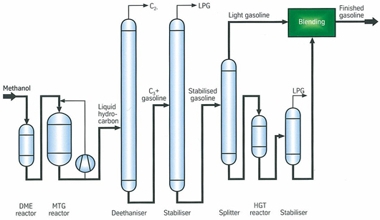These are less common than ethanol-gasoline blends but do find application in countries including China where the composition range available is M15 to M80 (15% methanol and 80% methanol respectively, balance gasoline in each case). Vapour pressures of gasoline-methanol blends were studied by Pumphrey et al., whose experimental work spanned the whole composition range from a pure sample of a particular gasoline to pure methanol.
Between about 20% methanol and 60% the vapour pressure of the blend is about 20 kPa higher than that of the gasoline only. There is then a steep drop, to 20 kPa below the vapour pressure of the gasoline for pure methanol, consistently with the statement above that methanol alone would at most attain the summer RVP of a gasoline.

Viscosities of methanol-gasoline blends have been examined in a recent piece of work by Lee. Blends of a gasoline of API index 53° and methanol were examined at 20°C. The gasoline alone had a kinematic viscosity of 0.51 cSt. A blend comprising 15% of this gasoline balance methanol, that is an example of an M85 fuel, had a kinematic viscosity of 0.73 cSt. It was stated that gasolines have kinematic viscosities in the range 0.4 to 1 cSt, and the example given for an M85 fuel is comfortably within this range.












